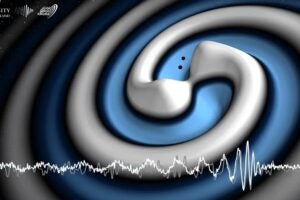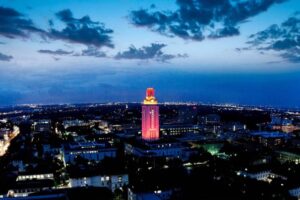AUSTIN, Texas—An international team of researchers led by Dr. Neal J. Evans II of The University of Texas at Austin department of astronomy has been selected as one of six “Legacy” teams for the Space Infrared Telescope Facility (SIRTF). Evans is the Edward Randall Centennial Professor in Astronomy.The goal of the Legacy program is to obtain data bases of lasting value in several key areas of astrophysics. The SIRTF is scheduled to be launched in July 2002.
The UT Austin team will study the process by which stars form out of molecular clouds of gas within Earth’s galaxy, concentrating on observation of dense and embedded cores inside molecular clouds that are located within 1,000 light years of Earth.
By obtaining the most comprehensive census of objects in different stages of development, the Evans team will be able to unravel the history of these clumps of dust and gas as gravity condenses them into stars and disks. The disks around these newborn stars are the source of planetary systems, for example, the Earth’s solar system.
The team will coordinate observation plans with a Legacy team at the University of Arizona, which will follow the process to still later stages, as the disks form planets and dissipate. The two teams will produce a database of unprecedented scope, providing the roadmaps for further investigations.
Legacy teams are charged with planning the observations, enhancing the data quality by more advanced analysis, adding data from other observatories and supplying advanced analysis tools to subsequent researchers. The Legacy program data will be made available to the scientific community as quickly as possible, to allow time for planning follow-up studies.
UT Austin astronomy professor Dr. Paul M. Harvey will serve as deputy team leader. The team includes researchers at the University of Leiden in the Netherlands, the Smithsonian Astrophysical Observatory in Cambridge, Mass., the University of Pennsylvania, the University of Maryland, the California Institute of Technology and the Jet Propulsion Laboratory.
The infrared spectral region is ideally suited to probe the dust-enshrouded regions where stars and planets form. Visible light is completely blocked in the early stages of the process, leaving astronomers in the dark about many aspects of star formation. Detailed observations of the infrared light via spectroscopes also will allow the team to study the changes in the dust throughout the process.
The dust begins as tiny, sub-micrometer chunks of silicate or carbon. It then acquires mantles of icy material, including water, carbon dioxide and methanol, within the dense cores of molecular clouds. This substance grows by collisional accretion, which basically means it collides and sticks together, ultimately providing the building blocks for planets such as Earth, as well as the raw materials for life.
The SIRTF has several special features that will greatly increase the ability of astronomers to detect extremely faint objects. It has a beryllium mirror 85 cm in diameter (about 33 inches), which will be cooled to about 5 degrees Celsius above absolute zero (or about -450 degrees Fahrenheit). Cooling the telescope enormously decreases the infrared emission from the telescope itself, a limiting factor for most observations in the infrared. The combination of low emission, freedom from interference by the Earth’s own atmosphere and advanced infrared detectors is expected clearly to reveal objects that have been extremely difficult to detect until the development of the telescope.
For more information, contact Joel Barna of UT Austin’s McDonald Observatory and department of astronomy at (512) 471-6335.



